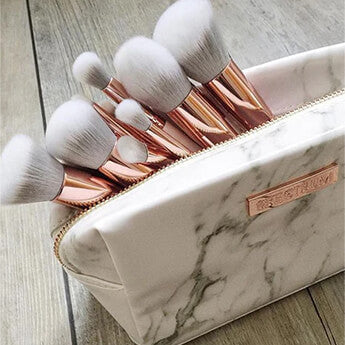How to edit your make-up brush collection: the pro’s guide


Hands up who has a large – and growing- collection of make-up brushes, that do little more than clog up their make-up bag? Guilty. A quick tally at Roccabox HQ revealed that 8 out of 10 of us owns at least 5 make-up brushes that we never use – and admittedly have no idea what to use them for. So in order to brush up on our brush knowledge (ahem), we decided to put it to the professionals to create an edit of the ONLY make-up brushes we need for our face and we vowed to learn – once and for all – how to use each and every one of them. Consider it Feng Shui for your make-up bag and the key to a flawless face. You can thank us later…
Do we really need lots of different brushes for our face? It’s all so confusing…
In a word, yes. Put it this way: the brush you use for applying your bronzer, for example, shouldn’t be the same brush you use to apply your brush. Aside from colour transfer (we don’t want rosy blush all over our forehead…) the size, shape and types of bristles you use, all differ according to purpose. So, these are the brushes you need to know about if you want a flawless, glowing, defined face:
Foundation Brush – The majority of make-up artists agree that a good foundation brush is the key to a flawless, long-lasting base and if HD-ready skin is your goal, a flat stiff brush will allow you to work in small amounts of foundation effectively, so you can build up coverage to look natural. Blank Canvas Cosmetics’ F01 Face Brush* is our must-have tool for nailing a flawless application. Use to apply foundation, before using it again to ‘buff’ the product into your skin, for a perfect finish. Buff and blend in a stipple motion. The bristles on this gorgeous looking brush are extra soft (not to mention vegan and antibacterial) plus when you aren’t using it as a foundation brush, and its bristles are still dry, it can double up as a powder brush.
Tapered Brush – if defined cheekbones are your goal (erm, aren’t they everyone’s?) then a slanted, precision brush like Make Up For Ever's Precision Blush Brush no. 150 is your tool. The angular bristles hug the contours of your cheeks, so application is effortless. Use to apply a darker shade in to the depths of your cheeks. Using a matt bronzer or shading powder, place the brush at the center of the ear, guide towards the tip of the nose and stop shortly before the corner of the eye. Use with either cream or powder – we prefer powder for a buildable, blendable, more seamless finish.
Blusher Brush – you need something much smaller than your bronzer brush, as you want to limit blush application to the apples of your cheeks, and a smaller head of bristles gives you better control. Try Charlotte Tilbury’s round-headed Blusher Brush for adding a flush of colour to cheeks. Also doubles up as a highlighter brush, for adding powder highlighter higher up on cheekbones.
Bronzer Brush – after contouring (that’s the tapered brush, remember) you need a larger brush with very soft bristles, to give skin an all-over sunkissed glow. Go large, go fluffy, and remember to blend blend blend - particularly around your hair and jawlines. Dust an extra layer of bronzer underneath your chin to add flattering definition and to draw the eye away from any double-chin action. Try Charlotte Tilbury's Bronzer Brush.
Should we choose natural or synthetic bristles?
Synthetic bristles don’t absorb oils, which makes them the best choice for liquid and cream formulas, such as foundation and cream blush. Natural bristles are more porous than their faux friends, making them a much better choice for powders as they will pick up more product. They’ll also blend them into your skin better.
We’re very time-poor – be honest, do we really need to clean our brushes?
YES! Laboratory-based tests on make-up and application tools have shown up all sorts of different microbes that can cause infection. If we don’t regularly clean our make-up brushes, bacteria can build up on the surface from constantly being in contact with our skin, and can lead to infections such as conjunctivitis. Microbes such as Pseudomonas aeruginosa and MRSA can also live on old makeup and cause more serious inflammation and sepsis, which can sometimes be life-threatening. Convinced yet?
Got it. So, how should we look after them?
Shampoo is a good start. A gentle, baby shampoo is a good alternative to a brush cleansing solution: try adding antibacterial tea-tree oil (a tip we picked up from Kim K’s make-up artist) to the shampoo beforehand. Organic soap or skin cleanser also works. And how often should we be cleaning them? Skin brushes that we use daily should be cleaned once a week, to prevent build up. All other brushes – eyeshadow, blush etc – will benefit from a once a month cleanse.
*you'll find one in your September Roccabox!
